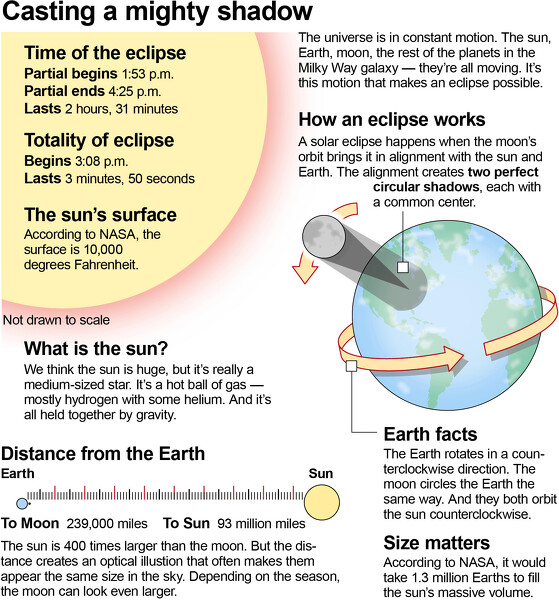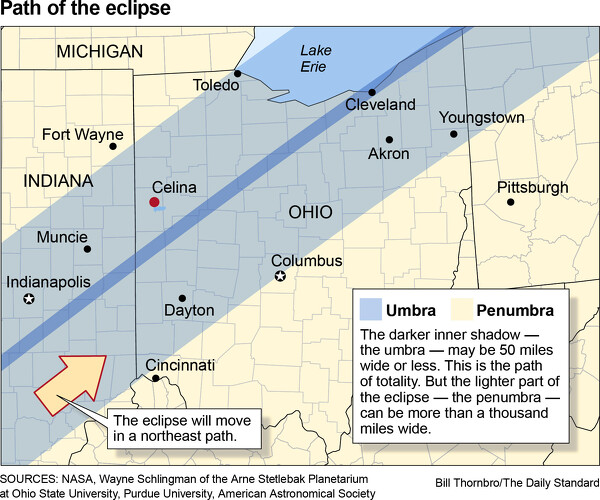CELINA - In just one week, a historic total solar eclipse will pass through the Grand Lake region. But, what is a total solar eclipse? And what will it look like?
A solar eclipse is when the moon passes between the Earth and the sun, Wayne Schlingman, Director of the Ohio State University Arne Slettebak Planetarium said.
The total solar eclipse will occur in Ohio on April 8, beginning at 3:08 p.m. with the final exit of the moon's shadow about 4 minutes later, according to http://ema.ohio.gov.
During the eclipse, the moon will line up perfectly between the Earth and the sun, blotting out the sunlight. It will take just a couple hours for the moon's shadow to slice a diagonal line from the southwest to the northeast across North America, briefly plunging communities along the track into darkness.

How an eclipse works
Eclipses only happen twice a year during eclipse seasons when the sun, Earth and moon align, Schlingman said. Otherwise, the moon is usually too far above the plane of the earth or below the plane of the orbital plane of the Earth.
"It doesn't ever cast a shadow, but during those two times of (the) year, we have a chance to get a solar eclipse and a lunar eclipse," he said. "We call those eclipse seasons."
A lunar eclipse is visible to anybody who's on the nighttime side of the earth, so it is really easy to see a lunar eclipse, he added. They're still rare and interesting, but they are something that people can see more regularly.
"Whereas a solar eclipse, we can see the partial solar eclipse, like part of the sun might be covered more often, but it's much harder to be in the exact path of totality where the tiny bit of the moon's shadow hits the earth," he said. "(It) blocks out the sun's light completely, so that's what we're going to experience as a total solar eclipse."

Path of the eclipse
This eclipse will be twice as long as the 2017 solar eclipse, he said, because the moon is closer to earth. Due to this, the moon will be bigger and it will block out more of the sun.
"It's still blocking out the sun, but it's blocking out more of the light, that means there's a bigger shadow on the earth," he added. "It'll be darker, last longer and it'll be easier to see the stars."
In addition to stars, onlookers will be able to see multiple planets, and potentially a comet will brighten the sky as it passes around the sun, he added.
"We're also observing this eclipse during solar maximum, that's when the sun has the most activity, the most sun spots on the surface," Schlingman said. "It's the most active at its surface, but that means the corona's going to be really spiky this time around. Last time, it was smooth and had like three pieces. This time it's going to be potentially really spiky and I can't tell you exactly what it'll look like, but it'll be cool."
The next total solar eclipse, in 2026, will grace the northern fringes of Greenland, Iceland and Spain.
North America won't experience totality again until 2033, with Alaska getting sole dibs. Then that's it until 2044, when totality will be confined to Western Canada, Montana and North Dakota.
There won't be another U.S. eclipse, spanning coast to coast, until 2045. That one will stretch from Northern California all the way to Cape Canaveral, Florida.
Aside from Carbondale, Illinois, in the crosshairs of both the 2017 and 2024 eclipses, it usually takes 400 years to 1,000 years before totality returns to the same spot, according to NASA Program Scientist Kelly Korreck.
The event will be a once-in-a-lifetime occurrence, Schlingman said.
"To be able to show your kids something like this, this is something that they will carry with them the rest of their life, and it might be the only time they ever see it in their whole life."
- The Associated Press contributed to this report.
